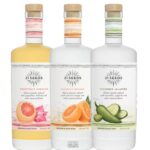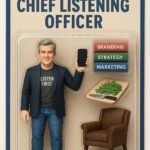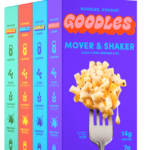Today’s post was inspired by a wonderful blog by my friend Derrick Daye from Branding Strategy Insider. I love innovative and counterintuitive strategies!
It is filled with sage wisdom.
It is called 61 Ways to Differentiate Your Brand. I’d urge you to read it. Like all of his content on that site, it is inspiring and educational.
While on an 8-hour flight to Hawaii, I started brainstorming my own list. I keep an ongoing list of ideas from brands I observe so I had a running start.
Thanks for the inspiration, Derrick.
70 Ways To Differentiate Your Brand from The Marketing Sage Consultancy
1. Reverse the business model: Offer a subscription for something typically bought outright. Example: Dollar Shave Club’s razor subscription service or 3M’s Filtrete air filters that show up at my front door every three months when I need to change them.
2. Extreme specialization: Focus on a hyper-specific niche within your industry. For instance, a restaurant that only serves cereal or a catalog for people who cook and garden but are left-handed.
3. Unexpected packaging: Present your product in a completely novel way. Consider Pringles’ unique tube packaging for potato chips or Liquid Death Water in a can instead of a plastic bottle.
4. Radical transparency: Share every aspect of your business operations with customers. Everlane does this with its “radical transparency” approach to pricing.
5. Counterintuitive pricing: Price your product differently from industry norms. Consider Costco’s low-priced, high-quality Kirkland brand. Or eliminate some “window dressing” features so you can give consumers 80% of the value for half the price.
6. Environmental focus: Make sustainability your core brand value. Patagonia stands out with its environmental activism and product repair services. They urge you NOT to buy during Black Friday and focus on ways to make their products last longer.
7. Customization at scale: Offer personalized products at mass-market prices. NIKEiD allows customers to design their shoes online.
8. Simplification: Remove standard features or services to focus on core values. Unlike most competitors, IKEA doesn’t assemble or deliver furniture. Chipotle makes ordering excruciatingly easy.
9. Unlikely partnerships: Collaborate with brands from completely different industries. Think of the unexpected Taco Bell and Doritos partnership. Here are more collab thoughts.
10. Extreme customer service: Offer an unparalleled level of customer care. Zappos is known for its exceptional customer service, including its 365-day return policy. Have a phone number with the name of a real human being, not a damn chatbot. (Call Jeff at 919 720 0995 if you need help)
11. Reverse positioning: Position your brand as the opposite of what’s expected in your category. Method cleaning products stand out with stylish, eco-friendly designs in a typically utilitarian category.
12. Time-based differentiation: Offer your product or service at unconventional times. Consider a breakfast-only restaurant open 24/7 or a breakfast-for-dinner chain.
13. Location innovation: Sell your product in unexpected places. An example is vending machines for high-end electronics like Best Buy Express.
14. Sensory branding: Focus on engaging senses typically ignored in your industry. Singapore Airlines’ signature scent creates a unique sensory experience.
15. Gamification: Incorporate game-like elements into your product or service. Duolingo makes language learning engaging through gamification.
16. Crowdsourcing: Involve customers in product development or decision-making. Lay’s “Do Us a Flavor” contest lets customers create new chip flavors.
17. Extreme convenience: Make your product or service easy to use or access. Amazon’s 1-Click ordering streamlines the purchasing process.
18. Retro revival: Bring back old-fashioned elements in a modern context. Polaroid’s revival of instant cameras appeals to nostalgia in the digital age.
19. Social impact integration: Build social responsibility directly into your business model. TOMS’ one-for-one model donates a pair of shoes for each purchase. Charity Water’s approach to marketing by supporting water projects around the world.
20. Artificial scarcity: Limit availability to increase desirability. Supreme’s limited product drops create buzz and demand. Here is a post with more detail on this idea.
21. Bundling innovation: Combine products or services in unexpected ways. ClassPass bundles access to various fitness studios under one membership.
22. Reverse trial: Offer a complete product experience before purchase. Warby Parker’s home try-on program lets customers test glasses before buying.
23. Extreme personalization: Tailor your product to individual customer data. Stitch Fix uses AI and personal stylists to curate clothing boxes for each customer. This is a great way to differentiate your brand.
24. Unbranding: Minimize or eliminate traditional branding elements. Brandless sold unbranded products to focus on quality and value. Although unsuccessful, the idea has some value in certain market segments. (No Ad Suntan lotion).
25. Experience-centric approach: Airbnb shifts the focus from product to overall experience. It sells unique travel experiences rather than just accommodations.
26. Micro-manufacturing: Produce items in tiny batches. Example: A brewery that makes only one barrel of each unique beer recipe. Brands need a way to differentiate themselves from the pack.
27. Hyper-local focus: Cater exclusively to a specific geographic area. Consider a delivery service that only operates within a single neighborhood.
28. Age-specific targeting: Design products or services for a very narrow age range. For instance, a clothing or shoe line exclusively for 65-90-year-old women.
29. Seasonal operations: These operate only during specific times of the year. For example, a pop-up store that’s only open during the winter holidays.
30. Extreme durability: Offer products with unusually long lifespans or warranties. Briggs & Riley offers a lifetime guarantee on their luggage.
31. Repurposing focus: Build a brand around giving new life to discarded items. An example is a furniture company that only uses reclaimed materials.
32. Deliberate imperfection: Embrace and highlight flaws in your products. Consider a pottery brand that celebrates the Japanese concept of wabi-sabi. Here is a post on this topic.
33. Customer co-creation: Allow customers to be part of the production process. For example, the Build-A-Bear Workshop lets customers create their own stuffed animals.
34. Negative-option pricing: Charge customers for not using your product or service. For example, a gym could charge more if members don’t visit frequently enough.
35. Radical honesty: Be brutally honest about your products, including flaws. Cards Against Humanity often uses self-deprecating marketing.
36. Extreme minimalism: Offer the bare minimum in a category known for excess. Muji stands out with its no-logo, minimalist approach to retail.
37. Time-limited existence: Create a brand with a predetermined end date. The Hundreds Homebase in LA was designed to close after 100 days. Selling vintage runs like wine that are limited and only available for a fixed period.
38. Bartering system: Allow customers to trade goods or services instead of using money. A cafe could accept homegrown produce as payment. See A Place At The Table, where you can volunteer time to help pay for your meal.
39. Analog in a digital world: Offer non-digital alternatives in tech-dominated fields. Moleskine thrives by selling paper notebooks in the age of digital notes. Differentiate or die. You can’t follow the category.
40. Edu-tainment focus: Combine education and entertainment in unexpected ways. Nerd Fitness turns to get in shape into a role-playing game.
41. Extreme personification: Give your brand a detailed persona or backstory. Trader Joe’s creates a nautical-themed personality for its stores.
42. Single-ingredient focus: Build a brand around one ingredient or material. The Ginger People offers a wide range of ginger-only products.
43. Forced scarcity: Limit how much of your product customers can buy. Movie theaters often limit ticket purchases to prevent scalping.
44. Randomized offerings: Let chance determine what customers receive. Mystery subscription boxes offer surprise items each month.
45. Anti-choice: Paradoxically attract customers by offering fewer choices. Steve Jobs famously limited Apple’s product line to reduce decision fatigue.
46. Hyper-specific problem-solving: Focus on solving one problem. Squatty Potty addresses a single-bathroom issue.
47. Micro-sponsorship: Allow customers to sponsor tiny parts of your business. For example, a zoo might let patrons sponsor individual animals.
48. Nomadic business model: Constantly change your business location. The Dessert Museum in Manila regularly changes locations and themes.
49. Inconvenience as a feature: Make your product deliberately hard to obtain. Cronuts gained fame partly due to the long lines to get them.
50. Generational targeting: Design products specifically for multi-generational use. A board game company could create games for grandparents and grandchildren to play together.
51. Extreme customization: Allow customers to modify every aspect of your product. Imagine a snack mix or cereal brand where buyers can design every detail. Differentiate your brand with hyper customization can be a winning approach.
52. Anti-technology stance: Reject modern technology in your operations. A tech-free hotel could appeal to those seeking a digital detox.
53. Hyper-flexibility: Offer unprecedented levels of adaptability in your service. For example, a gym with no fixed classes, only on-demand personal training.
54. Micro-payments: Divide your product or service into tiny, affordable increments. For example, a streaming service could charge by the minute watched instead of a monthly fee.
55. Radical inclusion: Design your product to be usable by everyone, including the often overlooked. For example, create a clothing line that caters to all body types and abilities.
56. Hyperlocal sourcing: Source all materials or ingredients from within a tiny radius. A restaurant could source everything from within 5 miles.
57. Charitable integration: Integrate charitable giving directly into your business model. Newman’s Own donates 100% of profits to charity. It is a charity dressed up as a food company.
58. Extreme simplification: Offer a product stripped down to its essentials. Light Phone offers a mobile phone that only makes calls or phones for the elderly with big buttons and simple functionality.
59. Customer-set pricing: Allow customers to decide what to pay. Panera Bread experimented with pay-what-you-want restaurants.
60. Anti-packaging: Sell products with minimal or no packaging. Lush Cosmetics sells many products “naked” without any packaging.
61. Micro-targeting: Create products for micro-customer profiles. For example, create a dating app exclusively for left-handed vegans. Narrow focus is a great strategy to be differentiate your brand.
62. Slow commerce: Emphasizes slowing down the buying process. Slow Food movement restaurants focus on locally sourced, carefully prepared meals.
63. Hybrid business models: Combine two unrelated business types. A laundromat that’s also a bar, for instance.
64. Reverse retail: This model turns the traditional retail model on its head. Bonobos started as an online-only retailer with physical locations used only for trying on clothes.
65. Hyper-specialization in time: Offer your product or service only at very specific times, such as a pop-up restaurant that’s only open during full moons. Differentiate through limited availability.
66. Anti-choice architecture: Design your offerings to reduce customer choice fatigue. The Capsule Hotel in Japan offers a single, simple accommodation option.
67 Micro-leasing: Lease products for very short periods. Rent the Runway allows customers to rent designer clothes for a few days.
68. Radical accessibility: Make your product, such as a 24/7 unmanned store using honor system payments, is unprecedentedly available.
69. Preservation focus: Build your brand around maintaining or restoring old items. The Real Real focuses on reselling luxury goods.
70. Hyperlocal experience: Create products or services that can only be experienced in one specific location. For example, a restaurant whose menu changes based on what’s growing in its attached garden.
Was this list helpful for you to differentiate and find an innovative idea?
What other ideas can you add in the comments section?
Connect with Jeff at The Marketing Sage Consultancy. Interested in setting up a call with me? Use my calendly to schedule a time to talk. The call is free, and we can discuss your brand and marketing needs. If you want to learn more about my new offering, The Trusted Advisor Board, you can click here to learn the details. Feel free to email me at jeffslater@themarketing sage.com or text 919 720 0995. Thanks for your interest in working with The Marketing Sage Consultancy.

Photo by Karina Carvalho on Unsplash




